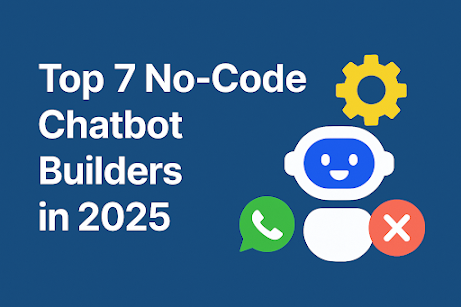7 Best No-Code AI Chatbot Builders to Explore in 2025
Creating AI chatbots no longer requires months of development or coding expertise. With the rise of no-code platforms, businesses of all sizes can now build intelligent bots that handle customer support, generate leads, and even automate internal processes — all without writing a single line of code.
As we move into 2025, the chatbot landscape continues to evolve, with platforms offering smarter language models, improved integrations, and faster deployment. But not every builder serves the same purpose. Some focus on training bots from your content, while others prioritize multichannel communication or internal support.
Here’s a look at seven of the top no-code chatbot builders that stand out in 2025 based on functionality, use case flexibility, and overall ease of use.
1. CustomGPT – For Domain-Specific Content Training
CustomGPT focuses on enabling bots that provide detailed, context-aware responses by learning from your existing content. This includes web pages, documents, manuals, or internal knowledge bases.
Key Highlights:
-
Allows ingestion of structured and unstructured content
-
Preserves tone and depth of original material
-
Suitable for technical, legal, and knowledge-rich sectors
Considerations:
While it offers strong content understanding, integration options are limited. It may not be ideal for those looking for pre-built support for messaging apps.
2. YourGPT – Versatile Builder with Multi-Source Training
YourGPT offers a comprehensive toolkit for designing, customizing, and deploying chatbots across multiple platforms. It’s particularly well-suited for businesses with varied needs — from customer support to internal helpdesk automation.
Core Features:
-
Trains bots using websites, PDFs, videos, and CRMs
-
Includes UI customization, multilingual support, and API options
-
Deployable across web, WhatsApp, Messenger, Slack, and others
Use Case Suitability:
From eCommerce customer service to HR onboarding, YourGPT supports a broad range of scenarios thanks to its customization depth and flexibility.
3. Chatbase – Document-Based Q&A Automation
Chatbase simplifies chatbot creation by allowing users to upload documents or URLs. The platform then converts this content into a knowledge-powered Q&A system.
What It Offers:
-
Quick setup for FAQ-style bots
-
GPT-based language processing for accurate replies
-
Integration with tools like Slack and WordPress
Limitations:
Better suited for static content and information lookups. It’s not designed for dynamic interactions or complex workflows.
4. ChatSimple – Minimal Setup, Maximum Simplicity
ChatSimple targets users who want a working chatbot up and running in minutes. It’s designed to require minimal input and technical effort, making it appealing for small teams or solo users.
Strengths:
-
Easy setup using website content or FAQs
-
Over 90 language options available
-
Supports Messenger and Instagram integration
Scope:
Ideal for basic use cases like responding to website queries or lead capture, but may not scale well for businesses needing backend workflows or multi-app support.
5. QuickChat – Real-Time AI Agents for Web Use
QuickChat is focused on delivering responsive AI agents that work on real-time queries. It leverages your business data to support interactive sessions directly on websites or dashboards.
Functional Focus:
-
Responds quickly with GPT-based answers
-
Allows customization of tone and chatbot behavior
-
Works well for FAQs or basic internal tools
Trade-Offs:
Limited to web use and fewer channel integrations. Businesses seeking omnichannel presence may need to look elsewhere.
6. BotSonic – Balanced Option for SMBs
BotSonic is positioned as a mid-tier option for businesses looking to automate common customer interactions without a heavy technical learning curve.
Platform Capabilities:
-
Supports data training with GPT models
-
Includes basic multichannel options (WhatsApp, Telegram, etc.)
-
Provides an embeddable widget for websites
Who It’s For:
Great for growing companies seeking automation for support functions, though customization and future scalability may be constrained.
7. DocsBot – Designed for Internal Knowledge Sharing
DocsBot is built to help internal teams access company knowledge more efficiently. It converts documentation into searchable AI assistants that support onboarding or internal operations.
Primary Features:
-
Easy upload of manuals, guides, and SOPs
-
Simple setup aimed at non-technical users
-
Cost-effective for internal use
Usage Boundaries:
While excellent for internal knowledge bots, it doesn’t offer the branding, voice, or customer-facing capabilities required for marketing or public support bots.
Choosing the Right No-Code Chatbot Platform
Before selecting a chatbot builder, consider these factors:
-
Your Primary Use Case: Support, onboarding, lead generation, or internal knowledge.
-
Content Type: Static documents, dynamic website content, or real-time data sources.
-
Channel Requirements: Website-only or messaging app integration.
-
Customization Needs: Does your bot need branding, logic controls, or API actions?
-
Scalability: Consider future message volume and evolving workflows.
-
Language Support: For global businesses, multilingual options are key.
-
Compliance: Ensure data handling follows privacy regulations.
Final Words
The no-code chatbot platforms of 2025 are more powerful and accessible than ever. Whether you're a startup looking for rapid deployment or an established business improving customer experience, the right tool can save time, reduce support costs, and increase engagement — all without complex development cycles.
These seven builders each cater to different business needs. The key is understanding your objectives and choosing the tool that best fits them — not just the one with the most features.




Comments
Post a Comment